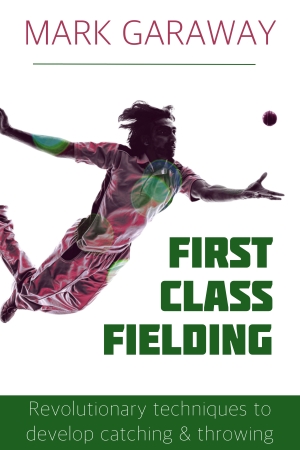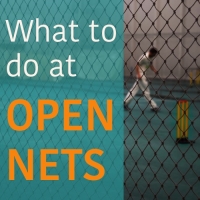Here's an Alternative to the Same Old Catching Drills
This video is a free sample of the online coaching course - First Class Fielding - from Mark Garaway
Catching drills are vital, but they can get a bit dull after doing them every session for weeks at a time. In this video Mark Garaway makes it competitive and fun for some fielders, while also helping the coach review technique.
It's simple but astonishly effective: Check it out here:
Video: How to Throw Down the Stumps
This video is a free sample of the online coaching course - First Class Fielding - from Mark Garaway. Click here for details
There are few better sights in cricket than a fielder hitting the stumps and performing a perfect run out. Yet we can all do more to improve player's ability to hit the stumps. In this free video, Mark Garaway talks about a simple and effective way to hit more often.
Richard Bailey on Practical Ways to Get Better at Cricket
Dr. Richard Bailey has written from a coaches view on helping players learn more quickly. Whether you coach or not, there are insights for becoming a better cricketer.
"According to some books for teachers, skill learning should take up to 3/4 of lesson time. As far as I can see, the only outcome of this approach is that learners switch off, and end up simply going through the motions. Effective practice activities should be relatively short, intense, and highly focused. They should also be immediately followed by an application in a meaningful game."
This article is refreshing is a land of dry theory because it gives several practical steps. It also opens up some ideas for discussion.
Catch it Soon: First Class Fielding with Mark Garaway
 EXCLUSIVE: Mark Garaway Announces Guide to First-Class Fielding Skills
EXCLUSIVE: Mark Garaway Announces Guide to First-Class Fielding Skills
Learn Cutting-Edge Catching and Throwing Skills
PitchVision Academy are delighted to announce Director of Coach Education Mark Garaway's first online coaching course, available on January 22nd.
We are delighted to have Garas first video coaching guide because his coaching CV in unparalleled. After a career in county cricket he moved into coaching aged 26 at Hampshire Academy, moving though Hampshire up to England analyst, Ireland Cricket, ECB Coach Education and his current role at one of England's premier cricket schools: Millfield.
There is no doubt that Mark Garaway is one of the premier coaches working in the world today. And that means you can apply his experience and advice with your team too.
Thank You India: What English Cricketers Learned from the Indian Experience

I'm writing this week's article from a coach travelling from Jalandhar to Delhi. The green countryside is rushing past and there are lots of Millfield cricketers chatting about the wonderful experiences that they have picked up to date on our Indian cricket adventure.
We have played 8 games so far in our 2 squads. We have 4 wins, 1 tie and 3 losses to our name. That's a fantastic effort considering the completely alien conditions that all the players have encountered: Heat, dust, spinning pitches, lots of spinners, doosras, excellent players and lots of travel have provided the challenge to our 29 players. They are doing brilliantly.
The biggest learning outcomes for me have been:
What Alan's Core Training Advice Taught Me About Batting Technique

Alan Murdoch was our Strength and Conditioning Coach at Millfield school (he recently picked up a new job with Bath Rugby). He speaks my language, and I used some of his fitness advice to improve batting technique.
When one of the players came into The Bubble and really struggled with balanced at ball strike, the solution to the problem was simple.
How to Build Resilient Cricketers

The final piece in the mental toughness jigsaw is resilience. Players scoring high in resilience have a great ability to bounce back strongly after any disappointment. Their confidence remains bulletproof for a long period of time, which protects them from the ups and downs of self-belief.
These players have a positive attitude towards the future. Resilience high players are focused on finding solutions and taking steps forward: Dwelling on problems is not something you will see in these characters.
These players experience disappointment, but they quickly move their focus on to regaining control and taking positive action.
Make Cricket Practice Constructive with this Boxing Drill

This is a guest article from Matt Thompson, Cricket Performance Director at Cardiff Metropolitan University. For more of Matt's work, find him on twitter and read his blog.
Picture the scene. It's time for training. You, as a batsman, have your regular opportunity for a constructive practice session with your coach or fellow team mates. Before you put your pads on, consider what does constructive actually mean? What does it look like for you?
Too many times at club, academy and university level, "constructive" takes the form of the batsman playing a glorious array of inappropriate shots without a game context in mind, inevitably squandering their wicket on a host of occasions.
I would be lying if I said I’ve never had one of these before myself as a player!
That is not constructive. So what is? Following on from David's article on having clear goals at open nets, here is one example of what "constructive" looks like.
Heart in the Oven, Head in the Fridge: Coaching Control in Critical Game Moments

The next element in our guide to recognising and developing mental toughness in our players relates to "Critical Moment Control" (CMC).
What is CMC? It's often described by the quote "heart in the oven and head in the fridge".
Players high in CMC always make the right judgements under pressure. Not only do they make the right decisions, they also follow through and deliver the goods: Clear mind, clear thinking, and unwavering execution.
These players control the situation with a strong mind: The situation does not control them. They show skilful thinking, skilful risk taking, and skilful execution. Each one is a great player to have around when it comes to finishing games off.
What to do at Open Cricket Nets
 How do you train when the coach or captain says "do what you like, just get something meaningful done"?
How do you train when the coach or captain says "do what you like, just get something meaningful done"?
Modern coaches are all about giving players freedom to train. This means you need to be self-reliant as a player and work out your own training, even at group sessions. Yet often I see players given freedom and unsure what to do with it. They end up with a half-hearted warm up and getting a few throw downs under the guise of "getting my eye in".
We can do better than that.
So, the next time you have to direct your own training, if there is a coach there or not, here is what to do.

